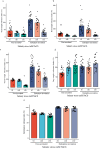Enhancing wheat resilience to salinity: the role of endophytic Penicillium chrysogenum as a biological agent for improved crop performance
- PMID: 40102779
- PMCID: PMC11921529
- DOI: 10.1186/s12870-025-06388-y
Enhancing wheat resilience to salinity: the role of endophytic Penicillium chrysogenum as a biological agent for improved crop performance
Abstract
Salinity stress severely impacts wheat productivity, necessitating effective strategies to enhance crop resilience. This study investigates the potential of Penicillium chrysogenum CM022 as a biological agent to alleviate the impact of salinity stress on wheat (Triticum aestivum L.). P. chrysogenum CM022 improved germination of wheat seeds, particularly under salinity of 150 mM NaCl. Fungal inoculation significantly improved plant growth in terms of root length, plant height, and seedling biomass, even under high salinity conditions. Notably, inoculated plants preserved photosynthetic pigments and reduced oxidative damage, evidenced by lower levels of hydrogen peroxide (H₂O₂) and malondialdehyde (MDA), compared to non-inoculated controls. The inoculated plants also exhibited enhanced proline and soluble sugar contents, which are crucial for osmotic adjustment under stress. Additionally, P. chrysogenum CM022 significantly increased the antioxidant capacity of wheat, boosting total phenolic and flavonoid contents, and enhancing antioxidant enzyme activity under high salinity. These findings underscore the potential of P. chrysogenum CM022 in improving wheat tolerance to salinity stress through physiological, biochemical, and antioxidant defense mechanisms, supporting its use in sustainable agricultural practices to mitigate the adverse effects of salinity on crop production.
Keywords: Penicillium chrysogenum; Antioxidant enzymes; Endophytic fungi; Salinity resilience; Seed germination.
© 2025. The Author(s).
Conflict of interest statement
Declarations. Ethics approval and consent to participate: Not applicable. Consent for publication: Not applicable. Competing interests: The authors declare no competing interests.
Figures








Similar articles
-
Seed priming with salicylic acid enhances salt stress tolerance by boosting antioxidant defense in Phaseolus vulgaris genotypes.BMC Plant Biol. 2025 Apr 17;25(1):489. doi: 10.1186/s12870-025-06376-2. BMC Plant Biol. 2025. PMID: 40240984 Free PMC article.
-
Seed Treatment with Trichoderma longibrachiatum T6 Promotes Wheat Seedling Growth under NaCl Stress Through Activating the Enzymatic and Nonenzymatic Antioxidant Defense Systems.Int J Mol Sci. 2019 Jul 30;20(15):3729. doi: 10.3390/ijms20153729. Int J Mol Sci. 2019. PMID: 31366159 Free PMC article.
-
Seed priming by sodium nitroprusside improves salt tolerance in wheat (Triticum aestivum L.) by enhancing physiological and biochemical parameters.Plant Physiol Biochem. 2017 Oct;119:50-58. doi: 10.1016/j.plaphy.2017.08.010. Epub 2017 Aug 18. Plant Physiol Biochem. 2017. PMID: 28843888
-
Seed priming to alleviate salinity stress in germinating seeds.J Plant Physiol. 2016 Mar 15;192:38-46. doi: 10.1016/j.jplph.2015.12.011. Epub 2016 Jan 16. J Plant Physiol. 2016. PMID: 26812088 Review.
-
Sustainable wheat (Triticum aestivum L.) production in saline fields: a review.Crit Rev Biotechnol. 2019 Dec;39(8):999-1014. doi: 10.1080/07388551.2019.1654973. Epub 2019 Aug 25. Crit Rev Biotechnol. 2019. PMID: 31448647 Review.
References
-
- Bohra A, Choudhary M, Bennett D, Joshi R, Mir RR, Varshney RK. Drought-tolerant wheat for enhancing global food security. Funct Integr Genom. 2024;24(6):1–32. - PubMed
-
- Elbagory M. Reducing the adverse effects of salt stress by utilizing compost tea and effective microorganisms to enhance the growth and yield of wheat (Triticum aestivum L.) plants. Agronomy. 2023;13(3):823.
-
- Kaya C, Ugurlar F, Ashraf M, Alam P, Ahmad P. Nitric oxide and hydrogen sulfide work together to improve tolerance to salinity stress in wheat plants by upraising the AsA-GSH cycle. Plant Physiol Biochem. 2023;194:651–63. - PubMed
-
- Gupta S, Schillaci M, Walker R, Smith PM, Watt M, Roessner U. Alleviation of salinity stress in plants by endophytic plant-fungal symbiosis: current knowledge, perspectives and future directions. Plant Soil. 2021;461:219–44.
-
- Khasanov S, Kulmatov R, Li F, van Amstel A, Bartholomeus H, Aslanov I, Sultonov K, Kholov N, Liu H, Chen G. Impact assessment of soil salinity on crop production in Uzbekistan and its global significance. Agric Ecosyst Environ. 2023;342:108262.
MeSH terms
Substances
Grants and funding
LinkOut - more resources
Full Text Sources

